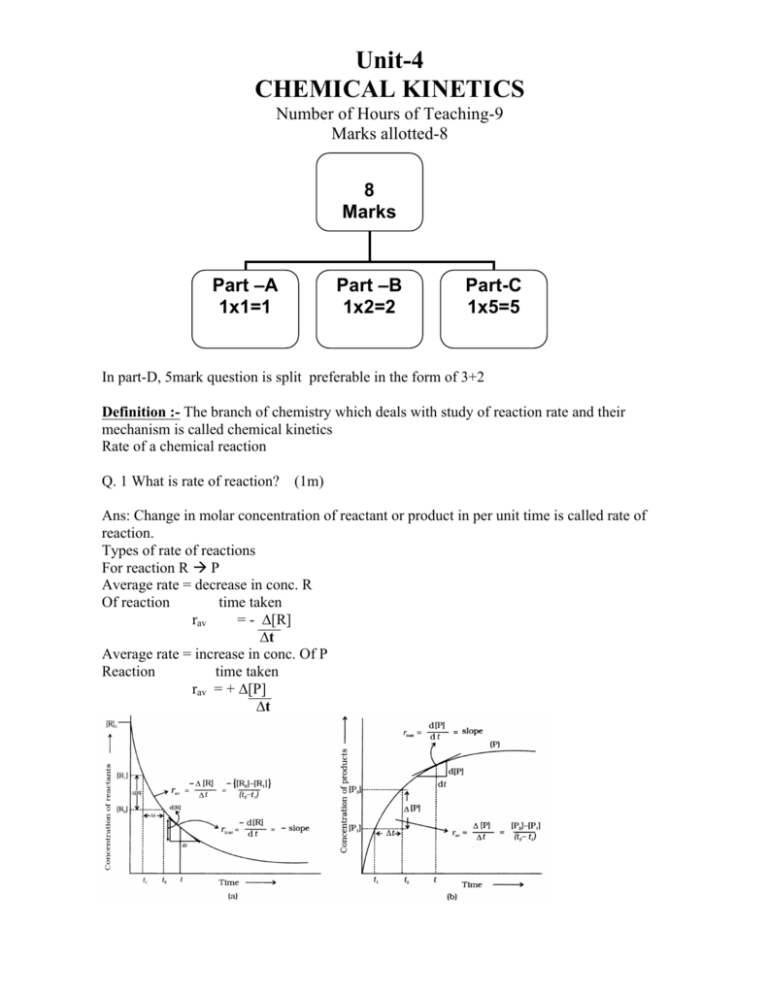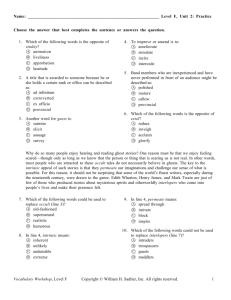Unit-4 CHEMICAL KINETICS
advertisement

Unit-4 CHEMICAL KINETICS Number of Hours of Teaching-9 Marks allotted-8 8 Marks Part –A 1x1=1 Part –B 1x2=2 Part-C 1x5=5 In part-D, 5mark question is split preferable in the form of 3+2 Definition :- The branch of chemistry which deals with study of reaction rate and their mechanism is called chemical kinetics Rate of a chemical reaction Q. 1 What is rate of reaction? (1m) Ans: Change in molar concentration of reactant or product in per unit time is called rate of reaction. Types of rate of reactions For reaction R à P Average rate = decrease in conc. R Of reaction time taken rav = - ∆[R] ∆t Average rate = increase in conc. Of P Reaction time taken rav = + ∆[P] ∆t Q2:- For the reaction RàP, the conc. of reactant changes from 0.03M to 0.02M in 25 min. calculate average rate of the reaction using the unit of time in seconds. rav= - ∆[R]= - (0.02-0.03 ) ∆t 25x60 =-[-0.01] 1500 = 6.66x10-6 M/s Q3: What is the SI Unit of rate of reaction ? (1m) Ans: Mol /L /s Factors influencing Rate of reaction Q4 :- Mention any two factors which influence the rate of reaction . 2M Ans 1) Pressure or conc. of reactants 2) temperature 3) catalyst. Dependence of rate on concentration . Q5.) What is rate law ? (1 m) Ans: Representation of rate of reaction in terms of concentration of reactants is called rate law. Rate expression and rate equation Q.6) Define rate equation or rate expression (2m) Ans: Expression in which reaction rate is given in terms of molar conc. of reactants with each term raised to some power which may or may not be same as the stoichiometric coefficient of the reacting species in a balanced chemical equation. Q.7) Define rate constant of a reaction. (1m) Ans: Rate constant is equal to rate of reaction when the product of the molar conc. of reactants is unity. Order of a Reaction Q.8) Define order of a reaction. 1M Ans: Sum of the powers of the concentration of the reactants in the rate equation is called order of reaction. Q.9) Calculate the overall order of a reaction which has the rate expression. 1M Rate= K [A]1/2 [B]3/2 Ans: Order of reaction = 1/2 + 3/2 =2 Q.10) What is elementary reaction ? (1m) Ans: Reaction taking place in one step is called elementary reaction. Q.11)What are complex reactions?(1m) Ans: Reactions taking place in more than one step are called complex reaction. Q.12) What is SI Unit of rate constant of nth order reaction ? (1m) Ans: (mol)1-n . Ln-1.s-1 Q.13) What is SI unit of rate constant of zero order reaction? (1m) Ans: Mol/L/s Q.14) What is the order of reaction whose unit of rate constant and rate of reaction are same ? (1m) Ans: Zero order. Q.15) Identify the reaction order from the rate constant K=2.3x10-5 mol-1.L.S-1 (1m) Ans: Comparing the unit of rate constant with general unit Mol-1.L.S-1 with ( Mol)1-n.Ln-1.S-1 1-n= -1 n=2 Molecularity of a reaction Q.16) Define molecularity of a reaction . (1 m) Ans: The number of reacting species taking part in an elementary reaction which must colloid simultaneously in order to bring about a chemical reaction is called molecularity of reaction. Q.17) In a complex reaction which step controls the overall rate of reaction and what is it called? (2m) Ans: Slowest step, which is called rate determining step. Q.18) The conversion of molecules X to Y follows second order kinetics .If conc. of X Increased to three times,how will it affect the rate of formation of Y ? (1m) Ans: Increased rate =( Increased conc.)n =32 =9 Rate of formation of Y increases by 9 times Integrated rate equations Q.19) Derive rate constant of zero order reaction Ans: Consider a zero order reaction R--> P Rate =-d[R] = K[R]o dt = - d[R] = K dt = d[R] = -kdt -------(1) (3m) Integrating equation (1) both sides [R]= -kt+I ----------(2) Where “I” is integration constant At t=0 [R]=[R]o where [R]o is initial concentration of ∴Eqn (2) becomes I=[R]o Substituting I in eqn-------- (2) [R] = -Kt + [R]o -Kt = [R]-[R]o Kt = [R]o-[R] K = [R]o-[R] t reactant. Q:20) Derive integrated rate equation for first order reaction? Ans-Consider a first order reaction. RàP Rate = - d[R] = K[R] dt d[R]= - K[R] dt d[R] = - K. dt. -------(1) [R] Integrating eqn.(1)on both side ln [R] = - Kt + I --------(2) Where “I” is integration constant At t=o [R]=[R]o which called initial Concentration reactant Substituting the values in ln[R]o= I Equation (2) can be written as ln[R] = -Kt + ln[R]o Kt = ln[R]o – ln [R] Kt = ln [R]o [R] Kt =2.303 log[R]o [R] K= 2.303 x log[R]o t [R] Log [R]o [R] o time Slope = K 2.303. Or K= 2.303xSlope (4m) Half life of a reaction Q21)Define halfe life of a reaction . (1m) Ans: The time in which the conc.of a reactant is reduced to one half of its initial conc. is called half life of a reaction (t1/2) Q:22) Show that half life of a zero order reaction is directly proportional to initial concentration of reactant from integrated rate equation. OR Derive the relation between half life and rate constant of zero order reaction .(2m). Ans:-Rate constant of zero order reaction is K= [R]o – [R] t At half life t =t ½ & [R] = ½ [R]o .: K= [R]o – ½ [R]o t1/2 K=[R]o 2t½ t ½ =[R]o 2K OR t ½ ∝ [R]o Q.23) Show that half life of a first order reaction is independent of initial Conc. of reactant from integrated rate equation (2m) Or Derive the relation between half life of a first order reaction and its rate constant . (2m) Ans: Rate constant of first order reaction is K= 2.303 x log [R]o t [R] At half life t=t ½ ,[R]=[R]o 2 .: K = 2.303 x log [R]o t½ [R]o/2 K =2.303 x log 2 t½ K= 2.303 x0.3010 t½ t½ = 0.693 K K= 2.303 x0.3010 t½ t½ = 0.693 K Q.24)A first order reaction is found to have a rate constant 5.5x10-14 /s .Calculate the half life of the reaction (2m) Soln. : K= 5.5x10-14 /s t½ =? t½ = 0.693 K = 0.693 5.5x10-14 t½ = 1.26x1013 sec Q:25) Show that the time required for 99/. Completion of a first order reaction is twice the time required for the completion of 90% of reaction( 4m) I set : [R]o= 100, [R]=[100-90]=10 t=t90% IIset : [R]o= 100 [R]= [100-99]1 t=t99% To be proved t99%= 2t90% K= 2.303 x log [R]o t [R] Sub. I set values . K= 2.303x log 100 t 90% 10 K = 2.303x log 10 t90% K= 2.303 X 1 - (1) t90% Substituting II set values K=2.303 x log 100 t99% 1 K= 2.303 x 2 --------------(2) t99% Comparing equations (1) & (2) 2.303x 1 = 2.303x2 t90% t99% t99% = 2t90% Pseudo first order reaction Q:26 Define pseudo first order reaction . Give an example. (2m) Ans: Chemical reactions which are not first order but behave as fist order reaction under suitable conditions are called pseudo first order Reactions. Ex: Inversion of cane sugar. C12 H22O11+H2O àC6H12O6 + C6H12 O6 Temperature dependence of the rate of a reaction Q:27)How does rate of reaction vary with temperature? Ans: Rate of reaction increases with increase of temperature. (1m). Q:28) What happens to the rate constant of a reaction when temperature is increased by 10o.? Ans: Rate constant increases nearly by two times. Q.29) Write Arrhenius equation which relates the rate constant , activation energy and temperature . (1m) Ans K= A e-Ea/RT Energy of activation Q.30) Define energy of activation (1m). Ans: The minimum energy required for the reactants to form activated complex is called Activation energy. Q.31) How is activation energy related to rate of reaction? (1m) Ans: Rate of reaction is inversely proportional to activation energy. ie r ∝ 1 Ea Q.32) How is activation energy affected by presence of positive catalyst? (1m) Ans: Activation energy of a reaction decreases in presence of catalyst. Q.33) On increasing 100K temperature rate of reaction becomes double, explain from the max well Boltzmann distribution curve. (2m) On increasing 100K temperature, substance Increases the fraction of molecules double,hence rate of reaction doubles. Q:34) How does positive catalyst increases the rate of reaction? (2m) Ans positive catalyst decreases the activation energy by changing the Path of the reaction,which increases the rate of reaction Collision theory of chemical reactions. Q:35) What is effective collision? How is it related to rate of reaction? (2m). Ans. Collision in which molecules colloid with sufficient kinetic energy and proper orientation so as to form products is called effective collision. It is directly proportional to the rate of reaction. Q:36)How is activation energy calculated by plotting graph ln K against 1/T ? (2m) Q:37)Write Arrhenius equation at different Temperature and rate constants. Ans: log K2/K1 = Ea X T2-T1 2.303RT T1 T2 Q:38)The rate constants of a reaction at 500K. and 700K are 0.02s-1 and 0.07s-1respeetively calculate the activation energy. (3m) Ans: log K2/K1 = Ea X T2-T1 2.303RT T1 T2 log 0.07 = Ea x 700- 500 0.02 2.303x8.314 500x 700 0.544 = Ea x 5.714 x10-4 19.15 Ea= 0.544x19.15 5.714 x10-4 Ea= 18230.8 J = Ea= 18. 2308 KJ.








